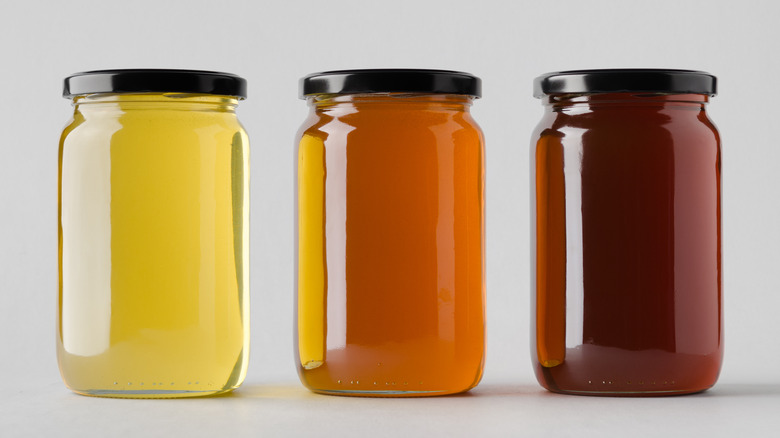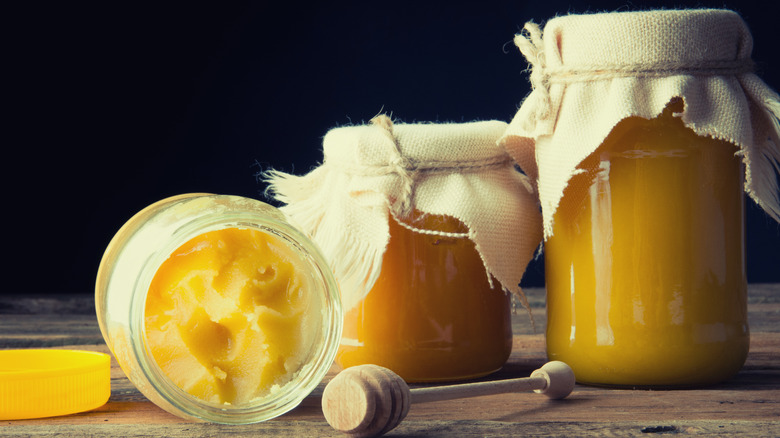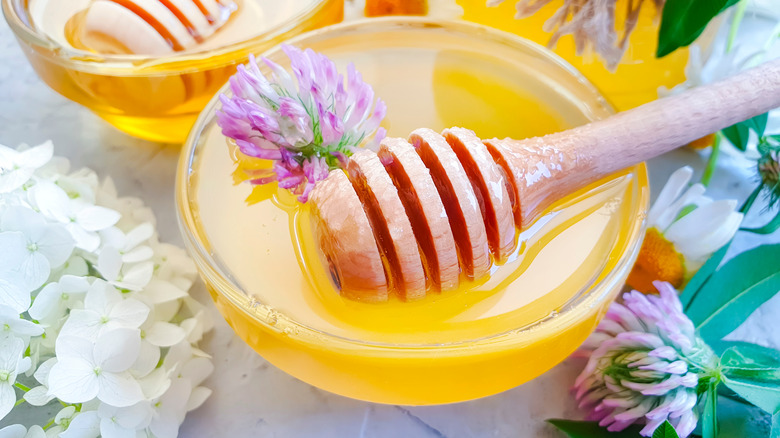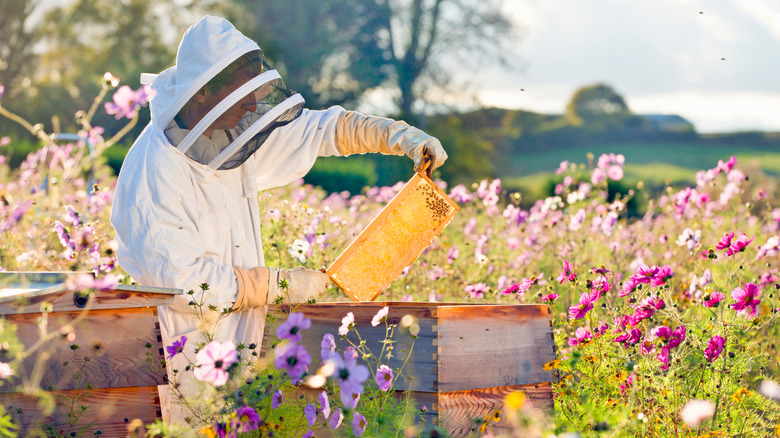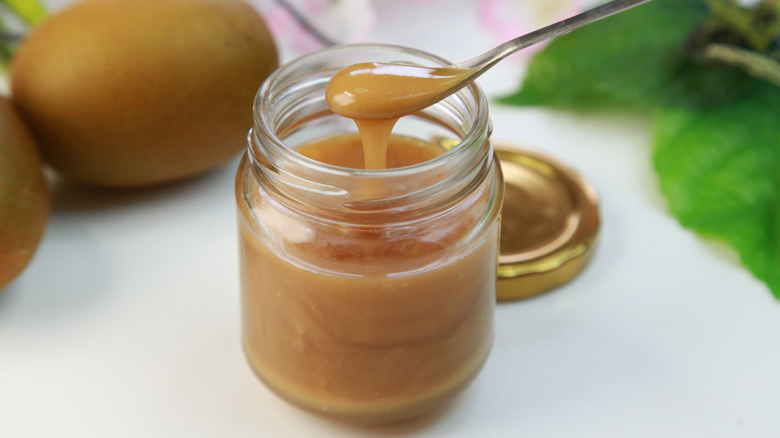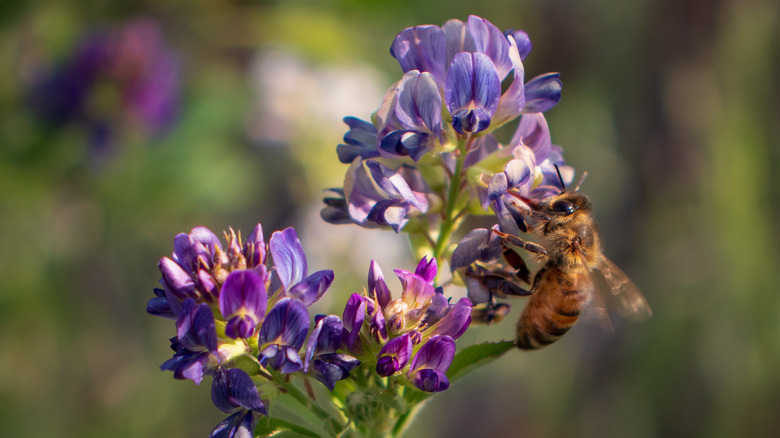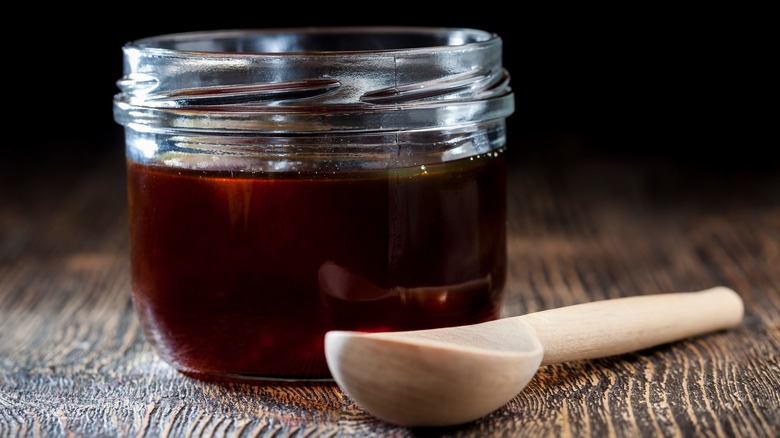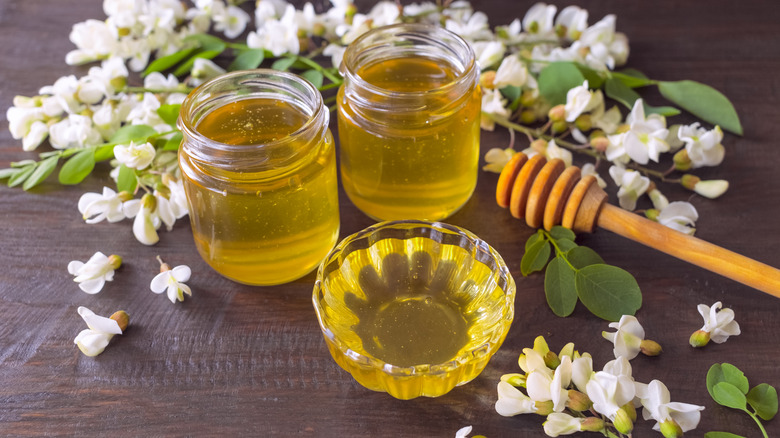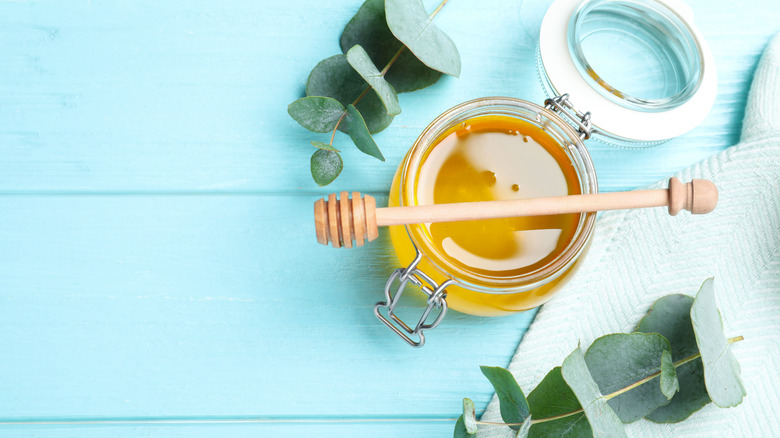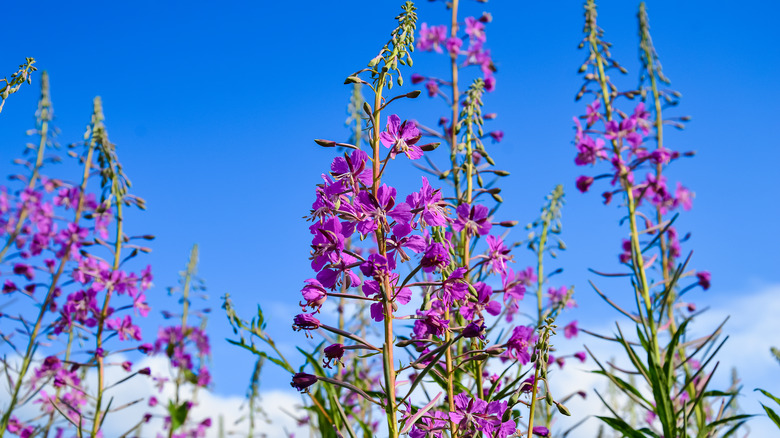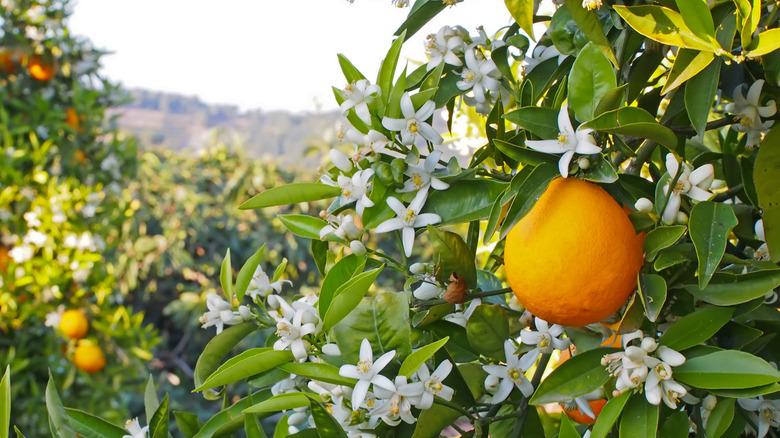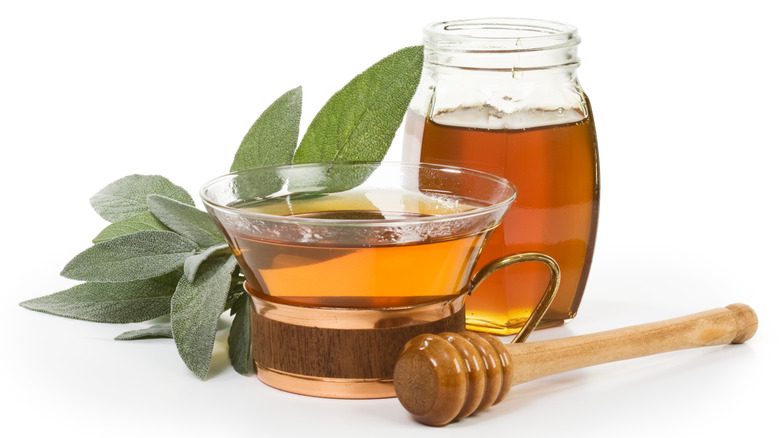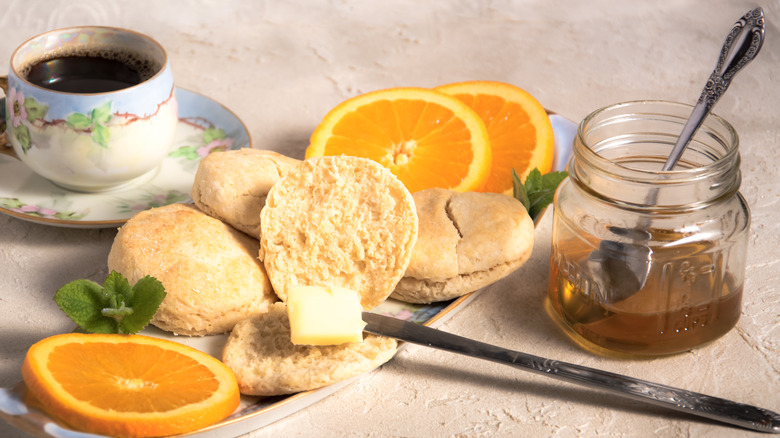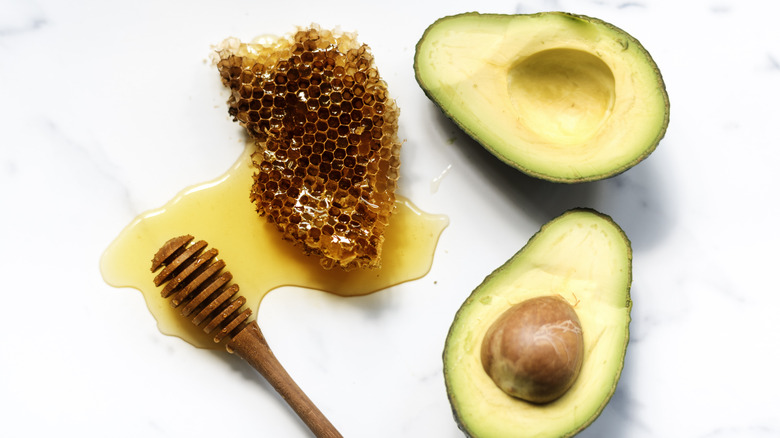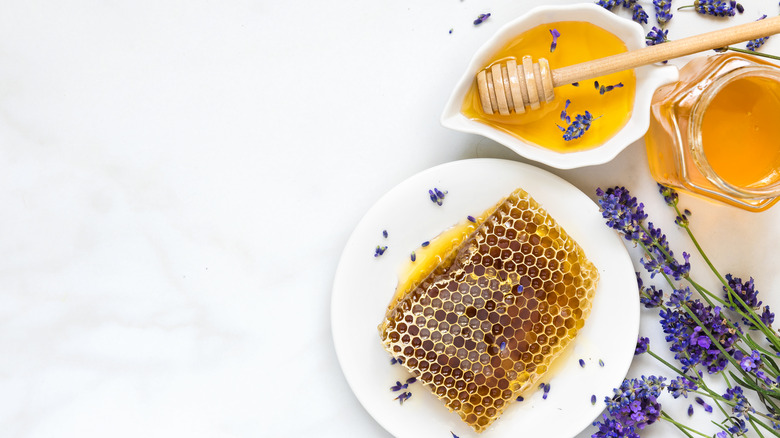The Ultimate Guide To Different Types Of Honey
Did you know that honey will never go bad? As a matter of fact, archeologists have found ancient jars of honey inside Egyptian tombs that were over thousands of years old. Honey is one of the few foods with a never-ending shelf life, as long as the jar is sealed tight and the honey is kept away from water or humidity. If any water gets in the mix, it can cause spoilage. Honey's natural combination of no water, high acidity, and enzymes added in by the bees make it almost invincible. It's been a sweet treat adored by many for ages.
If you've ever gone honey shopping, you've likely seen a lot of different varieties on the grocery store shelf. But where do all the honey flavors come from? As long as you're buying natural, unadulterated honey, you might be pleasantly surprised to know that the wide range of honey flavors is a result of where the bees source their nectar from. For example, lavender honey doesn't have lavender flavors added to it by humans — it's a product the bees make from the nectar of the lavender plants themselves. There are actually over 300 different types of honey available for sale in the United States alone (via National Honey Board). Let's explore some of the most popular honey varieties out there.
Raw honey
There's a big difference between raw honey and the pasteurized version. Honey holds a wide range of health benefits — however, you can only access these health benefits by consuming raw honey, since pasteurized honey is heated to high temperatures, which kills pathogens, but also beneficial nutrients (as per Healthline). Raw honey contains antioxidants, vitamins, and minerals, on top of having antibacterial and anti-fungal properties. In fact, in ancient times raw honey was commonly applied to wounds to support the healing process and ward off infection.
Most honey jars you will find in grocery stores are pasteurized, but many stores are starting to carry raw honey as well — just be sure to read the label. If it doesn't specify that it's raw or only heated to a certain low temperature, it's most likely pasteurized. You can also find raw honey at your local farmers' market or natural food store.
One caveat to purchasing raw honey is that eventually — and often quickly — raw honey will crystalize. This occurs when the natural sugars in honey start to bond together, harden, and form crystals. It can cause the honey to turn into a thick paste or give it a crunchy, chewy texture. You can use still honey in this state, but if your recipe calls for a more syrup-like texture, simply place your jar of honey in a bowl of warm water to melt the crystals and soften it up.
Clover honey
Clover honey is one of the most common and well-known honey varieties on the market. This is most likely due to how abundant clover plants are — they grow all over Canada, the United States, Sweden, and New Zealand. They're weather resistant and the bees love them, so much so that clover honey is the most widely produced honey available. Packaged in the iconic plastic bear bottle, it's perhaps the most recognizable kind of honey for sale.
Clover honey is a consumer favorite because it's so versatile. With a light color and flavor profile, mild floral notes, and a touch of cinnamon, it pairs well with many types of food and drinks. It's tasty drizzled over pancakes or desserts, used as a sweetener in tea or other beverages, added into sauces, or added on top of yogurt or oatmeal. In general, it's understood that darker-colored honey has more nutritional value and medicinal benefits compared to lighter-colored varieties, since potent antioxidants like polyphenols have a darker shade. The light golden color of clover honey suggests that it doesn't contain as many antioxidants and nutrients as other darker honeys, but it's still a delicious addition to almost any food.
Wildflower honey
Wildflower honey is an umbrella name that refers to a type of honey that is sourced from a variety of wildflowers. This honey usually comes from bees that collect nectar in wide open fields with many wildflowers present, so it's nearly impossible to pinpoint exactly which plants the honey is collected from. Because wildflowers grow almost worldwide, this variety of honey can be made and sold across the globe, and varies in color and flavor profile depending on the region you buy it from and the season it is made.
In general, wildflower honey tends to have a medium golden color, landing somewhere in the middle between light and dark-colored honey. It's commonly used in a wide variety of foods, including breakfast staples like waffles, pancakes, and yogurt, or drizzled on top of dessert. It's also a popular ingredient used to make simple syrup for cocktails and tastes lovely in a cup of tea. Wildflower honey is also a tasty traditional addition to charcuterie boards.
Manuka honey
Manuka honey is a product of New Zealand and Australia that comes from the nectar bees collect from the blossoms of the manuka bush, which is native to both countries. Like other honey varietals, manuka honey has antiviral, anti-inflammatory, and antioxidant properties (as per Healthline). Compared to other honey, though, manuka honey has been shown to contain dramatically higher levels of antibacterial qualities. For this reason, this honey is a popular choice for topical wound application and to help fight bacteria that can cause upper respiratory tract infections (URTs) like the common cold, flu, or bronchitis. In fact, manuka honey has been shown to help speed the healing time of topical wounds and ease symptoms associated with URTIs like a cough, sore throat, runny nose, and congestion.
The higher medicinal value of manuka honey is reflected in its darker color. While it still maintains a slightly sweet taste, it also holds an underlying nutty flavor and bitter aftertaste. Its strong flavor makes a great addition to your herbal tea beverage when you are sick, but it's not as commonly used in many food recipes.
Alfalfa honey
Alfalfa honey comes from the vivid purple flowers of the alfalfa plant, which is grown mostly in America and Canada as food for different farm animals. If you've ever visited or driven through the northern and western regions of the U.S., you may have seen alfalfa blooming in agricultural fields. Alfalfa honey is a little more elusive because the plant's flowers are quite a challenge for the bees to pollinate.
Alfalfa honey has a similar appearance to clover honey — both are very light colored, almost a pale golden hue. It doesn't have much of a floral taste to it. Instead, it contains more earthy, herbaceous, and grassy flavors. It's somewhat bitter and slightly sweet, with minty and vanilla notes. Raw alfalfa honey is known to crystallize quickly thanks to its high content of glucose.
This type of honey is a popular ingredient in baking and cooking recipes due to its light flavor profile — it adds sweetness without extremely altering flavors or taking over the recipe. It can be used as a sugar substitute or added to different dishes like sauces, salad dressings, yogurt, smoothies, tea, lemonade, and more.
Buckwheat honey
Buckwheat honey comes from the pollen of the tiny flowers of the buckwheat plant, a common grain used to make flour. This plant can be found growing in the U.S., France, Canada, Japan, and the Netherlands. Buckwheat honey is one of the darkest honeys around, with a deep amber color and a slight maroon tinge, which is a reflection of its high antioxidant content. These antioxidants have been known to help support immune system function and soothe coughs associated with the common cold and other respiratory infections (via Healthline).
Buckwheat honey is less sweet than other classic honey varieties, with a strong earthy smell and flavor. The taste and texture are almost similar to blackstrap molasses. For this reason, buckwheat honey is often used in cooking and baking recipes, although you can still use it on top of breakfast foods, desserts, or in tea if you enjoy the flavor. When using buckwheat honey as a sugar substitute in baking, it adds delightful moisture to the texture of the baked good, reducing its chances of drying out or cracking.
Acacia honey
On the opposite end of the spectrum, acacia honey is one of the lightest honeys out there, with a pale amber hue. This type of honey doesn't actually come from the acacia flower, but instead, it's sourced from the blossoms of the black locust tree, which is often called "false acacia." These trees can be found growing throughout eastern and southeastern North America.
It's a rare honey that's hard to find, since the black locust tree's nectar production is extremely weather dependent. If it's a good year, the flowers will bloom for about 10 days, but if it's a not-so-good year, they won't bloom at all. This gives the bees a very short window to collect and produce acacia honey.
The flavor of this honey is light and sweet, which pairs well with many foods and beverages, and tastes delicious all on its own. Acacia honey is popular among honey enthusiasts because the raw version is known to not crystallize quickly due to its high content of fructose compared to glucose.
Eucalyptus honey
Eucalyptus honey comes from — you guessed it — the flowers of the eucalyptus tree. This type of honey was originally made in Australia, where Eucalyptus trees thrive, but it's also now produced in California. Eucalyptus honey often has a medium amber color, sometimes with a greenish tint. The color, as well as the flavor and aroma, can vary depending on the environment and locations the trees live in.
Eucalyptus honey often has a flavor that mimics its highly aromatic nature, with refreshing notes of menthol and woody and earthy tones. Its health benefits are also similar to that of the Eucalyptus plant itself: Supportive of the respiratory system and helpful for easing symptoms of the cold, flu, and other respiratory infections (via Honey Green). Eucalyptus honey is a great addition to your herbal tea when you're not feeling well. It can also be added to recipes or drizzled on top of foods that will pair well with its invigorating, minty flavor profile.
Fireweed honey
Fireweed honey comes from the lovely flowers of the fireweed plant, a perennial wildflower that thrives in the Pacific Northwest and Alaska. Fireweed got its name because it's usually the first wild plant to sprout up after a wildfire. The flowers range in color from electric pink to dark purple. Fireweed is considered a medicinal herb, and the honey contains similar health benefits as well. It's traditionally used to soothe respiratory tract infections and stomach ulcers, and boost the immune system.
Known as the "Champagne of Honeys" for its crystal clear appearance and classic flavor, fireweed honey is very pale and light-colored, even lighter than the average wildflower honey. It tastes light, smooth, and sweet, with a decadent butter-like aftertaste. Its simple, classic honey taste means it goes well with most foods and drinks, and this honey varietal is known as a spectacular marinade ingredient for your favorite protein on the grill during barbecue season.
Orange blossom honey
Many honey varieties don't taste exactly like the plant they come from, but orange blossom is one lovely exception. Orange blossom honey reflects the bright, refreshing citrus and floral notes of the orange groves it originates from. It's cultivated throughout the world where orange trees thrive — countries like France, Mexico, Israel, Spain, and Italy. And in the U.S., orange blossom honey mostly comes from the sunshiny states of Florida, Texas, and California. It's a popular accent ingredient for many food companies — you may have seen it showcased in micro-brewed beers or specialty baked goods.
This honey offers a unique and tasty orange aroma and flavor that will keep you coming back for more. Its light color and flavor profile add a special touch to desserts, scones, biscuits, pancakes, tea, and more. When it comes to orange blossom honey, be sure to read the label, since many companies are known to add artificial flavoring to make the honey smell and taste like oranges. Try to only seek out raw and unprocessed jars of this varietal.
Sage honey
There are actually hundreds of different types of sage plants, many of which have been used for ages for both their culinary and medicinal benefits. The three most common species that sage honey comes from include the Black Button Sage, White Sage, and Purple Sage, which lead to slightly different color variations of sage honey. Most of the sage honey on the market originates from the U.S. or Greece. In California, Black Button Sage and White Sage are abundant, and from these plants the bees create a light golden sage honey, while Purple Sage dominates in Texas, producing a darker, deep purple honey.
Regardless of color, most sage honey has a light, sweet flavor profile and medium body, pairing well with tea, desserts, and breakfast foods. This variety of honey is often highly sought after because it doesn't crystallize as quickly as other types of honeys, making it perfect for drizzling on top of your favorite foods.
Tupelo honey
This rare variety of honey comes from the flowers of the tupelo tree, a species that thrives in the swamps of regions like Florida and the Amazon. This light-colored honey is so cherished that an entire festival is dedicated to celebrating it, appropriately called the Tupelo Honey Festival in Florida — Van Morrison even named a song after it. Tupelo honey is often described as having floral, fruity, and even spicy notes, akin to the smell and taste of cinnamon. It's a popular choice for mead makers — considering the beverage is made by fermenting honey and mixing it with spices and fruits, using a naturally flavorful honey only adds more interest to the drink's flavor profile. Tupelo honey is also a well-known variety that does not crystallize due to its low sucrose content.
Tupelo honey is hard to come by, since the tupelo tree only blooms for two to three weeks out of the year during the spring. On top of that, the blossoms are also finicky and weather dependent, and reaching the hives to harvest the honey requires lengthy and strenuous boat trips. This is one of the many reasons why tupelo honey is considered such an exquisite tasty gem.
Avocado honey
Avocado honey is made by bees collecting nectar from the flowers of the avocado tree, which prefer to grow in warmer climates like Mexico, California, Central America, and Australia. The avocado trees bloom about the same amount of time as orange blossom trees — throughout most of the spring. However, avocado honey is still considered rare because the bees don't particularly enjoy pollinating these trees compared to others, due to the specific mineral content of the flowers.
It's well-known that darker honey varietals boast more health benefits, in addition to offering a much bolder and full-bodied flavor profile. Avocado honey is one of those types, with a medium amber color and rich, earthy taste similar to molasses. For this reason, avocado honey makes a great substitute for molasses or sugar in baking recipes. Its creamy, buttery texture also means it's great on top of breakfast foods, in desserts, or dissolved into your favorite tea or coffee.
Lavender honey
As you might expect, lavender honey has a sweet and slightly floral smell and taste to it. There are actually more than 39 different species of lavender, with the most common honey varietals coming from True Lavender, Spike Lavender, and Lavandin. You might notice subtle differences in flavor and aroma depending on the type of lavender plant and environment it was harvested in, but they are all still quite similar.
Lavender honey is often almost clear or a very light amber color and often boasts woody and fragrant camphor notes. Raw lavender honey is known to crystallize at an average rate, so not too fast, but it will eventually happen if it sits in your cupboard for long enough. You'll most likely eat it faster than that though, since this sweet, fine honey goes well with almost anything — try it in any foods or drinks that call for the addition of honey. It even pairs nicely with cheeses, like feta, blue cheese, or semi-soft cheeses.
